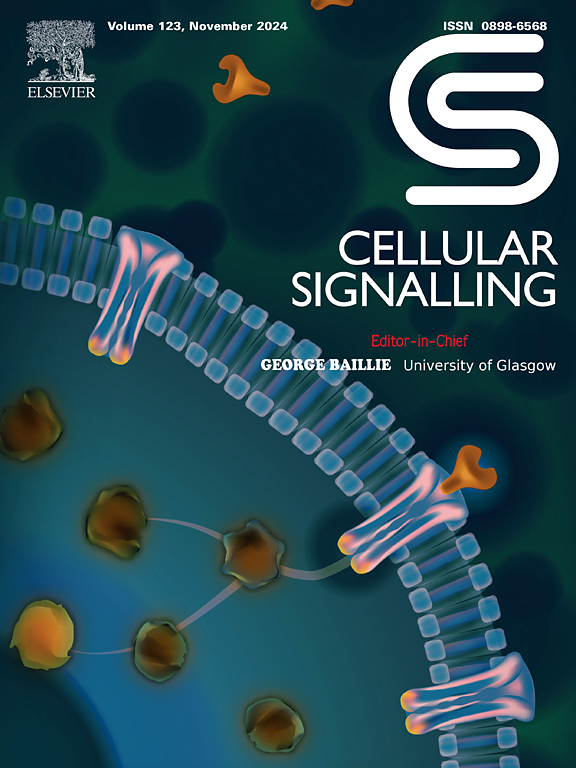Curcumin alleviates lipopolysaccharide-induced alveolar epithelial Glycocalyx damage by modulating the Rac1/NF-κB/HPSE pathway
IF 4.4
2区 生物学
Q2 CELL BIOLOGY
引用次数: 0
Abstract
The glycocalyx, a cell surface component implicated in various diseases, has recently been recognized for its role in acute lung injury (ALI). Also known as the alveolar epithelial polysaccharide coat, it is vital for maintaining lung barrier integrity, fluid homeostasis, and defense against pathogens. This study investigated the protective effects and mechanisms of curcumin, a natural polyphenol, against lipopolysaccharide (LPS) -induced alveolar epithelial glycocalyx damage. Key findings include: in vitro pretreatment with 20 μM curcumin for 2 h before a 24-h exposure to 10 μg/mL LPS markedly reduced heparan sulfate (HS) degradation by regulating heparanase (HPSE) expression. Mechanistic studies demonstrated that curcumin suppressed LPS-induced Ras-related C3 botulinum toxin substrate 1 (Rac1) expression and downstream nuclear factor kappa B (NF-κB) pathway activation, while upregulation of Rac1 protein abolished its protective effects. Furthermore, in vivo, administration of 200 mg/kg curcumin significantly reduced lung inflammation induced by 5 mg/kg LPS in mice. This treatment enhanced alveolar-capillary barrier function, evidenced by reduced levels of interleukin-6 (IL-6), IL-8, tumor necrosis factor-alpha (TNF-α), and HPSE. Curcumin also reduced damage to HS and syndecan-1 (SDC-1), a crucial component of the glycocalyx. This study is the first to indicate that curcumin protects against LPS-induced lung injury by reducing damage to the alveolar epithelial glycocalyx by inhibiting the Rac1/NF-κB/HPSE pathway.
姜黄素通过调节Rac1/NF-κB/HPSE通路减轻脂多糖诱导的肺泡上皮糖萼损伤
糖萼是一种涉及多种疾病的细胞表面成分,最近被认为在急性肺损伤(ALI)中起作用。它也被称为肺泡上皮多糖外壳,对于维持肺屏障的完整性、流体稳态和防御病原体至关重要。研究了天然多酚姜黄素对脂多糖(LPS)诱导的肺泡上皮糖萼损伤的保护作用及其机制。主要发现包括:20 μM姜黄素体外预处理2 h后,10 μg/mL LPS处理24 h,通过调节肝素酶(HPSE)表达,显著降低硫酸肝素(HS)的降解。机制研究表明,姜黄素抑制lps诱导的ras相关C3肉毒毒素底物1 (Rac1)表达和下游核因子κB (NF-κB)通路激活,而上调Rac1蛋白则使其保护作用消失。此外,在体内,200 mg/kg姜黄素可显著减轻5 mg/kg LPS诱导的小鼠肺部炎症。通过降低白细胞介素-6 (IL-6)、IL-8、肿瘤坏死因子-α (TNF-α)和HPSE水平,这种治疗增强了肺泡-毛细血管屏障功能。姜黄素还可以减少对HS和syndecan-1 (SDC-1)的损害,SDC-1是糖萼的关键成分。本研究首次表明,姜黄素通过抑制Rac1/NF-κB/HPSE通路,减少肺泡上皮糖萼的损伤,从而保护lps诱导的肺损伤。
本文章由计算机程序翻译,如有差异,请以英文原文为准。
求助全文
约1分钟内获得全文
求助全文
来源期刊

Cellular signalling
生物-细胞生物学
CiteScore
8.40
自引率
0.00%
发文量
250
审稿时长
27 days
期刊介绍:
Cellular Signalling publishes original research describing fundamental and clinical findings on the mechanisms, actions and structural components of cellular signalling systems in vitro and in vivo.
Cellular Signalling aims at full length research papers defining signalling systems ranging from microorganisms to cells, tissues and higher organisms.
 求助内容:
求助内容: 应助结果提醒方式:
应助结果提醒方式:


